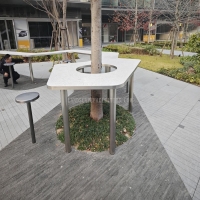Welcome to the website for landscape facilities products and knowledge.
What are the most important considerations for using the Landscape Round table in outdoor events?
When planning an outdoor event, the choice of furniture plays a crucial role in both functionality and atmosphere. Landscape Round tables have become increasingly popular for their unique blend of practicality and aesthetic appeal. These circular tables offer distinct advantages that can significantly enhance the outdoor experience for both hosts and guests.
One of the primary considerations when using Landscape Round tables outdoors is their weather resistance. Unlike indoor furniture, outdoor tables must withstand various environmental conditions including sunlight, rain, and temperature fluctuations. High-quality Landscape Round tables are typically constructed from durable materials such as powder-coated aluminum, teak, or synthetic wicker that can maintain their integrity and appearance despite exposure to the elements. The table's surface should be both waterproof and UV-resistant to prevent fading and water damage over time.
Space planning represents another critical factor in utilizing Landscape Round tables effectively. The circular shape of these tables naturally facilitates better conversation flow among guests compared to rectangular alternatives. However, this unique shape requires careful consideration of the venue layout. Event planners must account for adequate clearance between tables to allow for comfortable guest movement and service access. Generally, allowing at least 24-36 inches between table edges ensures sufficient walking space while maintaining an intimate setting.
The size and capacity of Landscape Round tables demand careful evaluation based on your specific event needs. Standard diameters typically range from 48 to 72 inches, comfortably accommodating between 6 to 10 guests respectively. Larger events might benefit from mixing table sizes to create varied seating arrangements, while more intimate gatherings could utilize uniformly sized tables throughout the venue. Consider the type of event - whether it's a formal dinner, casual cocktail party, or networking event - as this will influence both the table size selection and seating configuration.
Material selection extends beyond mere weather resistance to encompass both aesthetic and practical concerns. The table's material should complement the overall event theme and natural surroundings. For garden weddings, wooden tables might enhance the rustic charm, while contemporary corporate events might benefit from sleek metal designs. Additionally, the table's weight becomes a practical consideration - heavier materials provide stability in windy conditions but pose challenges for setup and rearrangement.
Comfort integration represents an often overlooked aspect of Landscape Round table usage. The circular shape allows for more natural interaction among guests, eliminating the hierarchical implications of head tables often associated with rectangular formats. This layout particularly benefits networking events and social gatherings where conversation is paramount. However, this configuration requires careful attention to seating arrangements to ensure all guests have clear sightlines to important focal points like stages or presentation areas.
Maintenance and storage considerations should influence your Landscape Round table selection. High-quality outdoor tables should require minimal maintenance between uses and stack or fold compactly for efficient storage. Tables with removable tops or collapsible frames offer significant advantages for events requiring frequent setup and breakdown. Additionally, consider tables with adjustable legs or leveling features to accommodate uneven terrain common in outdoor venues.
The aesthetic integration of Landscape Round tables with the overall event design cannot be overstated. These tables serve as both functional furniture and design elements that contribute to the event's visual appeal. The color, texture, and style of the tables should harmonize with other decorative elements, from centerpieces to linens and lighting. Many event planners utilize the circular form to create flowing, organic layouts that mirror natural environments, enhancing the outdoor experience.
Practical considerations for service efficiency must also guide Landscape Round table implementation. While the circular shape promotes conversation, it can present challenges for food service arrangements. Buffet setups, family-style service, or plated meals each interact differently with round table configurations. Event organizers should coordinate with catering teams to establish efficient service patterns that minimize disruption while maintaining the tables' social benefits.
Ultimately, successful implementation of Landscape Round tables in outdoor events requires balancing multiple factors including durability, spatial dynamics, guest comfort, and visual harmony. By carefully considering these elements during the planning phase, event organizers can leverage the unique advantages of circular tables to create memorable, engaging outdoor experiences that cater to both practical needs and aesthetic aspirations. The versatility of Landscape Round tables makes them suitable for various outdoor occasions, from weddings and corporate functions to casual social gatherings, provided their implementation addresses these essential considerations.
Related search:

Recommendation
An outdoor bar counter with stainless steel and terrazzo materials in an irregular shape